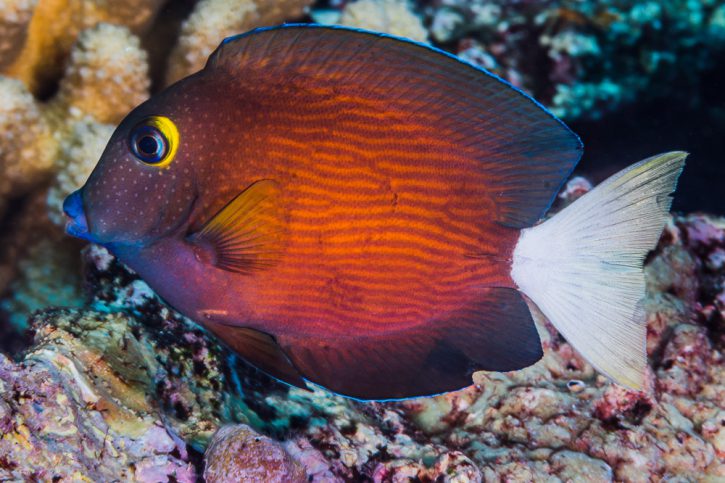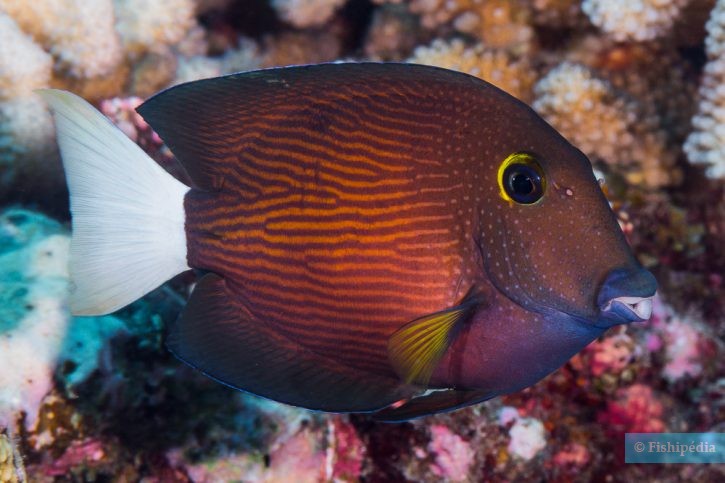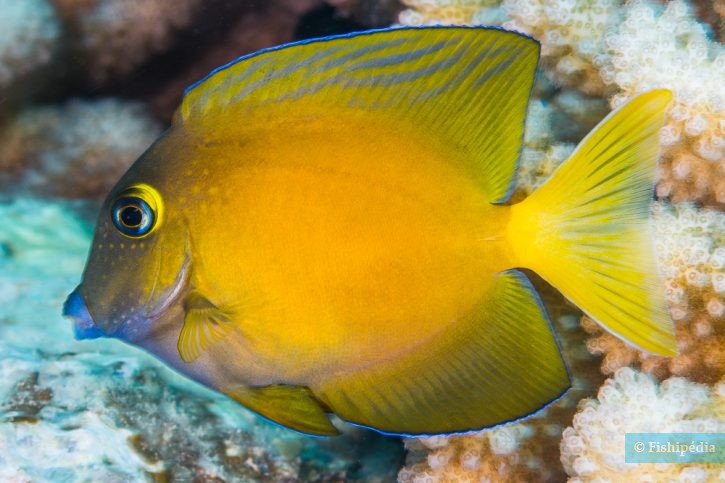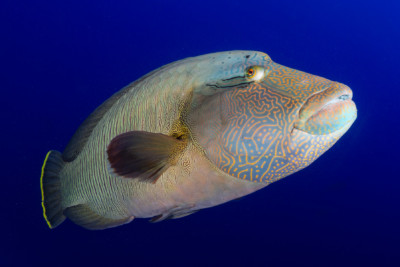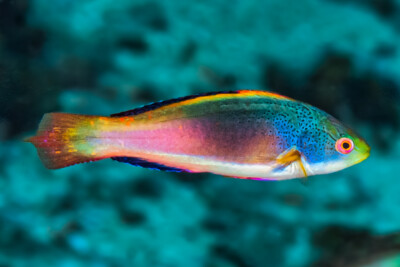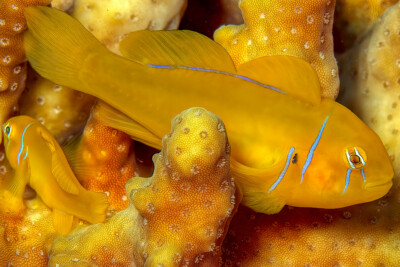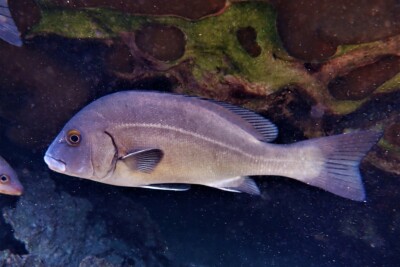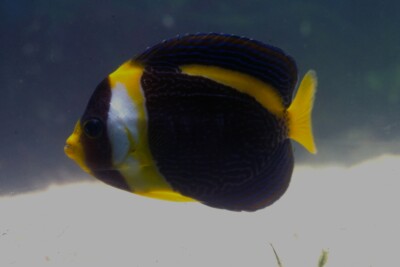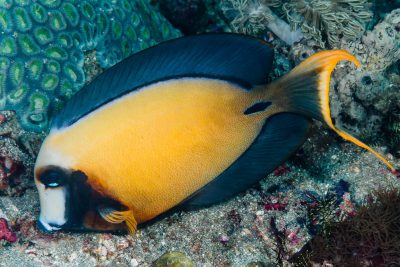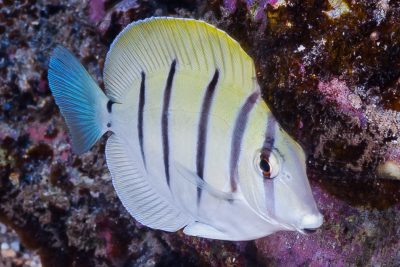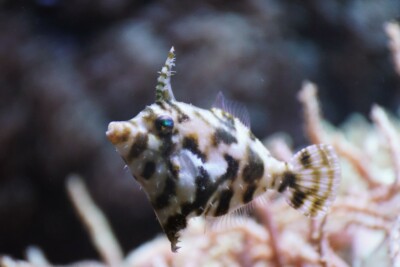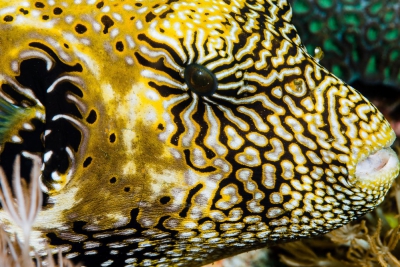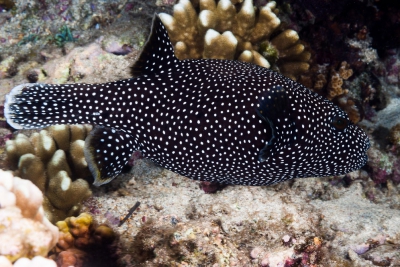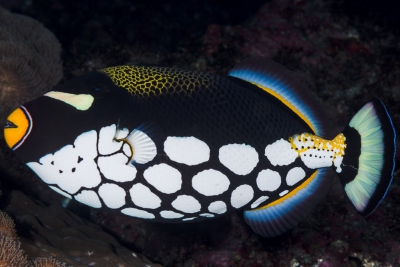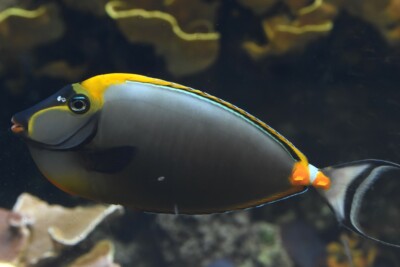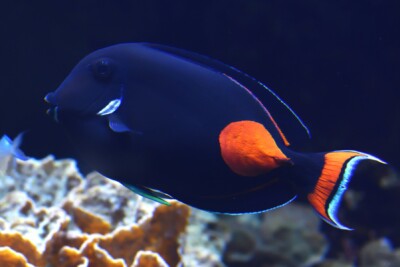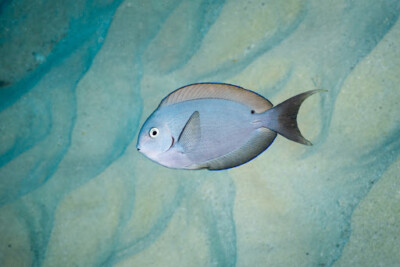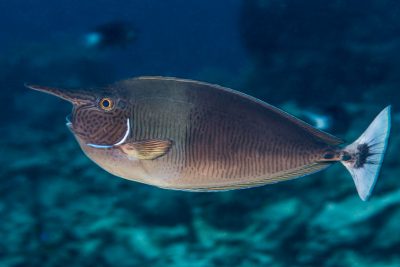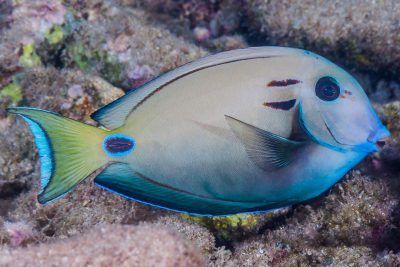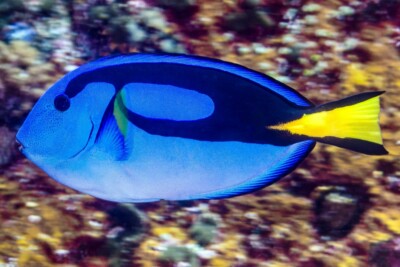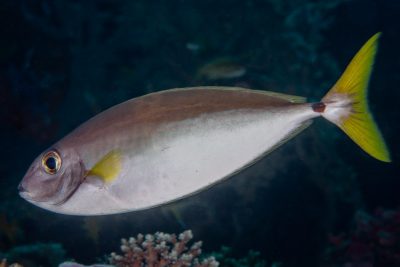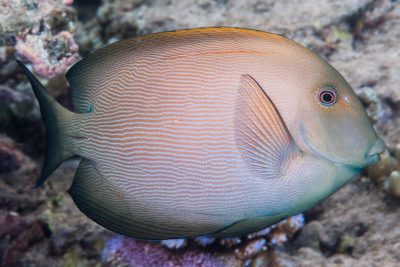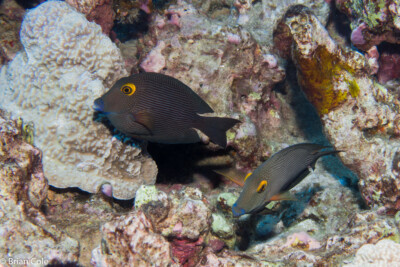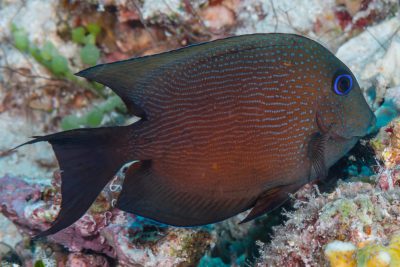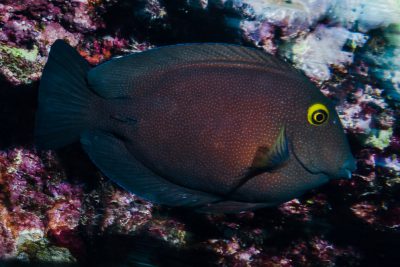whitetail bristletooth
| Scientific name | Ctenochaetus flavicauda |
|---|---|
| Descriptor | Fowler |
| Year of description | 1938 |
| IUCN category (World) | LC |
| Family | Acanthuridae |
| Genus | Ctenochaetus |
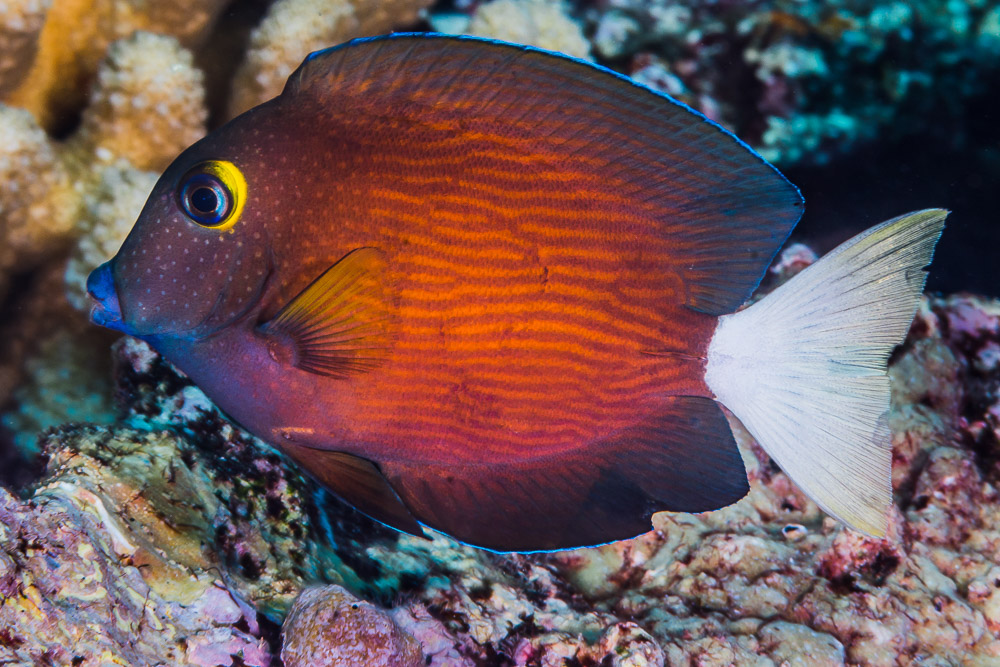

Introduction
Ctenochaetus flavicauda, also known as the whitetail bristletooth, is a tropical marine fish found in a large part of the Pacific Ocean.
Adults and juveniles exhibit completely different colorations. Juveniles are uniformly flashy yellow. As they grow, the coloration changes from gray-blue to ultimately brown-orange tones.
The whitetail bristletooth is one of the most studied marine species by scientists. The entire genome has been sequenced, allowing for a precise reconstruction of its phylogeny.
Who is it?
Morphology
-
Type
-
Average size14 cm
-
Maximum size16 cm
-
ShapeOvoid
-
Patternhorizontal stripes
-
Type
-
Average size14 cm
-
Maximum size16 cm
-
ShapeOvoid
-
Patternhorizontal stripes
How to recognize This fish ?
The adult is multicolored with a body that can be red, orange, black, brown, or beige. Generally, the body has darker horizontal stripes. The head has white spots. The muzzle is bluish. The juvenile is bright yellow.
The body is oval, laterally compressed. The eye has a yellow rim on its back.
The pectoral and pelvic fins are yellow with a flashy blue rim. The dorsal and anal fins are dark and have the same blue rim at their tips. The caudal fin is white with a slightly yellowish tip. The caudal peduncle has a brown-colored scalpel.
Sexual dimorphism
There is no apparent dimorphism in this species.
Behaviour & Life cycle
-
dietomnivorous with herbivorous tendency
-
Sociabilityliving in small groups
-
territorialYes
-
Way of livingdiurnal
The whitetail bristletooth swims in small groups near reefs and shallow sandy areas. This active fish continuously grazes on rocks and other surfaces covered with algae and small invertebrates. It also ingests sand to aid in digestion.
This species shows no signs of inter- or intraspecific aggression.
Reproduction
-
Reproductionovipare
Like all Acanthuridae, Ctenochaetus flavicauda is an oviparous fish that likely spawns in open water. The eggs and then the larvae join the marine plankton immediately after spawning.
Harmless species
This species does not pose a particular danger to humans when encountered in its natural habitat. However, it is advisable to beware of the scalpel strikes that can cause small cuts.
Origin and distribution
Geographic distribution & Conservation
The species has a wide geographical distribution, and the different populations are not considered threatened.
Conservation status of populations (IUCN)
What is its habitat?
Natural environment characteristics
-
Temperature22 - 28 °C
-
Depth1 - 30 m
Biotope presentation
The whitetail bristletooth is most commonly found at a depth of less than 30 m. However, it is not impossible to find this fish at other depths. It inhabits sandy bottoms and coral reefs.
Species of the same biotope
Main recommendations for fishkeeping
Deontology
In order to preserve wildlife, if you acquire this animal, it must not be released into the wild. See also, the Fishipedia charter.
Fishipedia supports the practice of responsible and environmentally friendly aquarium keeping. We encourage maintenance if it is motivated by a desire to understand the biological functioning of living things and if it is done with respect for animal life.
We believe that aquaristics is an opening to the discovery of aquatic environments, especially freshwater, and that this knowledge is necessary to better protect and respect these environments. Logically, we refute the compulsive purchase of animals that would not find a sufficient and / or adapted place in the host aquarium.
Our recommendationsThese tips apply to adult species from breeding. With regards to water conditions, wild species or close relatives must be kept under the same conditions as in their area of origin.
-
Min volume300 liters
-
Population min1
-
Temperature22 - 28 °C
CharacteristicsThe characteristics below apply for adult species. They correspond to an average of cases, validated in maintenance condition.
-
Difficulty breedingThe farming difficulty is relative. It depends on experiments already carried out with similar species. First, it takes into consideration the robustness of the species, the ease of recreation of a favorable environment and the general behaviour with the other inhabitants of the aquarium.hard
-
Robustnesssensible
-
Behaviourslightly aggressive
-
Availabilityoccasional
General reminders
It is strongly advised to read the complete dedicated file and to get information on the feedbacks of maintenance of the envisaged animal, this to avoid any potential conflict whose end result is generally the death of the individual (or the other inhabitants). It is important not to overload your aquarium to limit pollution. This will make maintenance easier.
General reminder on maintenance datas
Le démarrage d'un aquarium est une partie primordiale pour l'équilibre et le bien-être des poissons. Lorsque l'on met en eau un aquarium, l'eau passe naturellement par un cycle biologique : le cycle de l'azote. Celui-ci dure environ trois semaines. Tous les 2 jours, nous vous conseillons de tester votre eau jusqu'à ce que le taux de nitrite soit à zéro pendant plusieurs jours d'affilée.
Pour accélérer ce cycle, vous pouvez utiliser un activateur de bactéries comme JBL Denitrol. Cette solution riche en bactéries vivantes et enzymes permet une mise en place rapide du cycle de l'azote. Les poissons peuvent alors être introduits plus rapidement.
Il est important de tester l'eau de son aquarium régulièrement pour maintenir un environnement sain pour les poissons et les autres habitants. Les tests d'eau permettent de mesurer les niveaux de différents paramètres tels que le pH, la dureté totale, ainsi que les taux de nitrates, de nitrites et d'ammoniaque.
Pour réaliser ces tests, vous pouvez utiliser des produits d'analyse spécialisés tels que JBL ProScan qui permet de réaliser un diagnostic de l'eau directement via un smartphone. Il existe également des coffrets de tests plus classiques de bandelettes, comme JBL PROAQUATEST.
En cas d’usage de l’eau du robinet, vous pouvez utiliser un conditionneur d’eau de type Biotopol de JBL pour éliminer les substances nocives comme le chlore, le cuivre, le plomb et le zinc. Les conditionneurs d'eau garantissent une meilleure santé aux poissons et une meilleure croissance des plantes.
Chlorine and chloramine are dangerous for the health of animals. Used to disinfect water, these agents are present in significant quantities in tap water. We recommend using an anti-chlorine agent every time you change the water. In addition to chlorine, treatments and medicines sold for aquarium use sometimes contain dangerous heavy metals in high doses.
Specific needs for the whitetail bristletooth
The whitetail bristletooth is a marine species which lives naturally at a temperature between 22 °C and 28 °C. For proper maintenance, the temperature should never exceed the 31°C for long periods. The whitetail bristletooth is sensitive to abrupt changes in parameters as well as to chemicals. Its acclimation in an aquarium must be done with special care to prevent it from developing diseases or weaknesses. Nitrate levels should remain below 25mg/L. To keep the water clean and unpolluted, plan on changing 20% to 30% of the water volume each month. In seawater, it is also possible to remove nitrates using one of the following methods: Jaubert, denitrator on sulfur, biopeletts, vodka method.
The whitetail bristletooth is a species whose maintenance is rather reserved for informed aquarists . It can only be successfully carried out by carrying out a minimum of documentation work. Special husbandry conditions can easily lead to the death of the species or other animals.
This species is generally available in specialized shops or from aquarium clubs. Specimens that have been bred for a long time are easier to breed, but special water parameters must be respected.
Cohabitation & Environment
Being a living in small groups fish, it is advisable to install at least 1 individuals in an aquarium of 300 liters minimum. Group maintenance is a prerequisite to ensure their well-being. Lonely individuals tend to quickly become stressed and become especially susceptible to disease.
The whitetail bristletooth may show signs of aggression. In general, this species should not be mixed with large territorial species or other overly aggressive species, in order to avoid possible stress or even injury.
However, it can coexist with other species with a peaceful temperament and with some slightly territorial neighbors, as far as the volume of the aquarium allows. It is important to avoid that two territorial species share the same living area in an aquarium of insufficient volume.
Tips for feeding
The whitetail bristletooth is omnivorous with herbivorous tendency.
This species can eat dry food (flakes, pellets), fresh food and frozen food. To avoid deficiencies, it is recommended to vary the types of food.
You should not overfeed your residents to avoid polluting the water. For most species, it is better to feed a few small portions each day rather than one large meal.
Reproduction protocol
-
egg-laying protectionNo
Hybridization risks
In general, it is advised not to mix several species of the same genus or different varieties of the same species, to avoid the risks of hybridization.
These animals might interest you
To go further
Sources & Contributions
Participation & Validation
The Fishipedia team and specialist contributors are committed to providing high-quality content. However, although the information comes from scientific sources or testimonials from specialists, the cards may contain inaccuracies.

Adrien Falzon

Benoit Chartrer
Translation
Translation done with the valuable contribution of our translators, who make this information available to a wider audience. We sincerely thank them for their commitment.
Bibliographic references
The complete mitochondrial genome of Ctenochaetus flavicauda (Acanthuriformes, Acanthuridae) - Liguo Yang - Yue Wang - Na Ying - Xuefeng Song - Yanqing Wu - Bo Qin - - 2020.
Ecological correlates of foraging periodicity in herbivorous reef fishes of the Coral Sea - N.V.C.Polunin - D.W.Klumpp - Elsevier Ltd - 1989.
Scientific partners
Tags
Species of the same family
Same genus
Species of the same biotope
